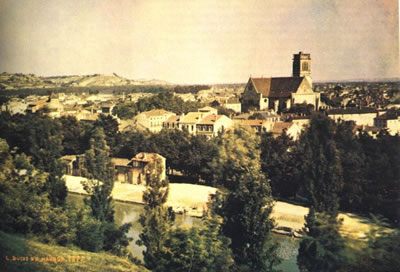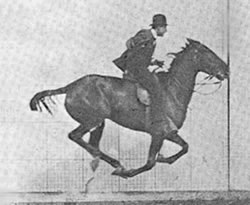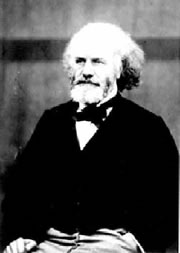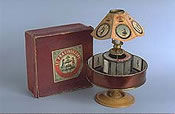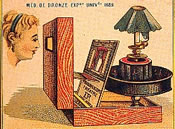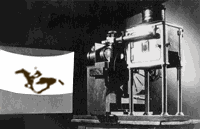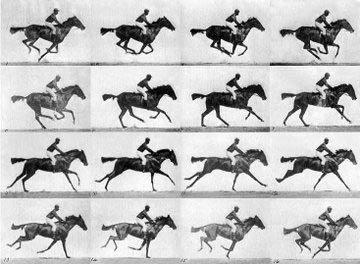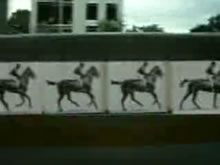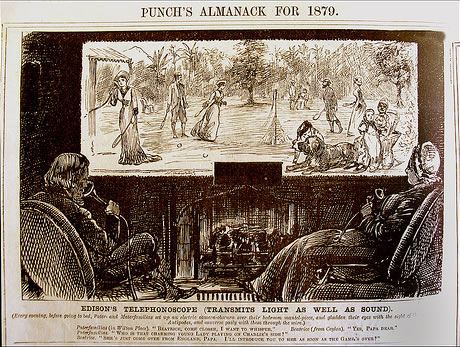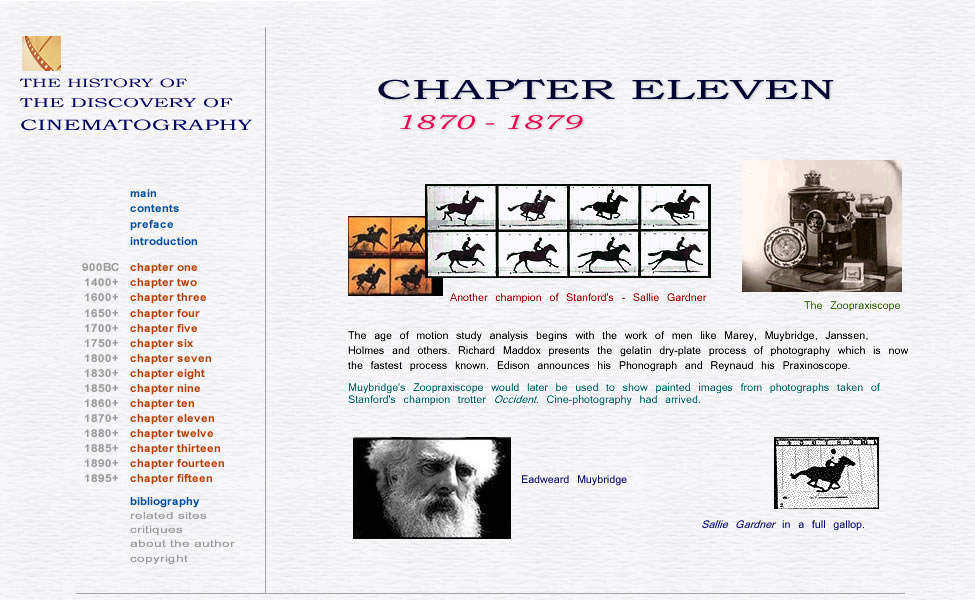 |
| |
|
|
|
| |
|
|
|
| |
|
|
|
| |
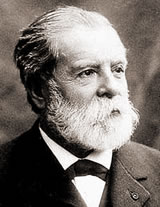 |
1870
√‰TIENNE-JULES MAREY - (1830 - 1904)
Marey
begins his initial studies into the possibility of analyzing the
motion of birds in flight. His work was advanced by the photographic
world‚€™s ongoing efforts to increase photoplate (surfaces) sensibility.
In contrast to the work of Muybridge who will photograph successive
views of animals and humans that pass before a stationary camera,
Marey will take his series of exposures on one plate, with one lens.
E.
J. Marey |
|
|
| |
|
|
| |
|
|
|
| |
|
|
|
| |
1870
HENRY RENNO HEYL ( - ) |
|
|
| |
Heyl gives us the Phasmatrope,
which combines persistence of vision and posed photographs
to produce an illusion of motion. It was styled from a magic lantern in
terms of projection mimickery. An entirely synthetic illusion was the
result of the Phasmatrope. Some have given Heyl the rights
to claim the first to project photographic motion pictures,
as an early promotional poster [ written from a letter by Heyl himself
] claims of the Heyl Phasmatrope. Published in the Popular
Science Monthly of July 1898 by Appleton; |
|
| |
|
|
|
| |
‚€œAmong
the earliest public exhibitions of photographs taken from living subjects
in motion projected by the lantern upon a screen was that given at an
entertainment held in the Academy of Music in Philadelphia, on the evening
of February 5, 1870, and a repetition of the exhibition was made before
the Franklin Institute at its next following monthly meeting, on March
16th, by the writer [Heyl]. The printed programme of this event contains
the following allusion to this feature of the entertainment:
"This is a recent invention, designed to give various objects and
figures upon the screen the most graceful and lifelike movements. The
effects are similar to those produced in the familiar toy called the
Zoetrope, where men are seen walking, running, and performing
various feats in most perfect imitation of real life. This instrument
is destined to become a most valuable auxiliary to the appliances for
illustration, and we have the pleasure of having the first opportunity
of presenting its merits to an audience. |
|
| |
|
|
| |
The
subjects exhibited embraced waltzing figures and acrobats, shown upon
the screen in life size, while the photographic images were easily three
fourths of an inch in height. At that day flexible films were not known
in photography, nor had the art of rapid succession picture-making been
developed; therefore, it was necessary to limit the views of subjects
to those that could be taken by time exposure upon wet plates, which photos
were afterward reproduced as positives on very thin glass plates, in order
that they might be light in weight. The waltzing figures, taken in six
positions, corresponding to the six steps to complete a turn, were duplicated
as often as necessary to fill the eighteen picture spaces of the instrument
which was used in connection with the lantern to project the images upon
the screen. |
|
| |
|
|
| |
The piece
of mechanism, then named the ‘phasmatrope,’ consisted of a
skeleton wheel having nine radial divisions, into which could be inserted
the picture, in such relative position that, as the wheel was intermittently
revolved, each picture would register exactly with the position just left
by the preceding one. The intermittent movement of the wheel was controlled
by a ratchet and pawl mechanism operated by a reciprocating bar moved
up and down by the hand. It will be apparent that the figures could be
moved in rapid succession or quite slowly, or the wheel could be stopped
at any point to complete the evolution. |
|
| |
|
|
| |
In
the exhibition at the Academy of Music above alluded to, the movement
of the figures was made to correspond to the time of the waltz played
by an orchestra, and when the acrobat performers were shown, a more rapid
motion was given, and a full stop made when a somersault was completed.
A shutter was then a necessary part of the apparatus to cut off the light
rays during the time the pictures were changing places.
|
|
| |
|
|
| |
This
was accomplished by a vibrating shutter placed back of the picture wheel,
that was operated by the same draw-bar that moved the wheel, only the
shutter movement was so timed that it moved first and covered the picture
before the latter moved, and completed the movement after the next picture
was in place. This movement reduced to great extent the flickering, and
gave very natural and lifelike representations of the moving figures.” |
|
| |
|
|
| |
This write-up from Appleton's
was also printed the same year in the Franklin Institute Journal
(April of 1898). The Phasmatrope exhibition of the waltz
was presented to an audience of 1,600. |
|
| |
|
|
| |
|
|
|
| |
|
|
|
| |
1870
JAQUES DESIRE FENAUT ( - )
|
|
|
| |
Fenaut was a manufacturer
of magic lanterns and in particular, an Episcope that
was illuminated by the sun. A mirror on the outside lit the interior with
more than enough light to project a very strong image. |
|
| |
|
|
|
| |
|
|
|
| |
1871
THOMAS ROSS ( - ) |
|
|
| |
As many did, Ross dreamed
of the use of photography on glass disks, and patented a form of Zoetrope
or wheel of life himself. |
|
| |
|
|
|
| |
|
|
|
| |
1871
RICHARD LEACH MADDOX ( - ) |
|
|
| |
Maddox begins using the
Gelatino-Bromide (gelatin dry-plate)
process of photography which is now the fastest form of process-photography.
Further speed in processing is made by boiling the emulsion. This process
allowed for photography to become an instantaneous one. |
|
|
|
|
|
| |
|
|
|
| |
1872
LIONEL SMITH BEALE ( - ) |
|
|
| |
Invents a projector in
England to project thinly cut brass rimmed images using intermittent shutter
action similar to the latter-known Maltese Cross projector.
He called his device a Chorentoscope, as did Molteni.
SEE 1866 BEALE. |
|
| |
|
|
|
| |
|
|
|
| |
|
|
| |
|
|
| |
1872
LOUIS ARTHUR DUCOS DU HAURON (1837 - 1920)
Louis Ducos du Hauron
in 1872 took the first photograph in color. The photograph (right)
was taken of the Angouleme Region in the south of France. Du Hauron
worked on both the subtractive and additive methods of color photography
during the 1860's and later published his findings in a paper
he titled 'Les Couleurs en Photographie'.
Du Hauron used the subtractive
method (using yellow-cyan-magenta) of color photography for this
first-ever color photo.
If you
have a printer connected to the computer you're sitting at, take
a look at the tri-color ink reservoirs inside it.
|
|
|
|
| |
The First Colour
Photograph
|
|
| |
|
|
| |
|
|
|
| |
|
|
|
| |
1872
EADWEARD JAMES MUYBRIDGE (1830 - 1904) |
 |
Muybridge
uses a battery of 24 cameras to photograph a race horse owned
by California Governor Leland Stanford. The resulting 24 pictures
taken as the trotting horse raced past, was the beginning of
what would become known as stop-action series photography.
Muybridge would continue the study of motion and the theory
of locomotion using animals, and later, humans. Muybridge's
investigations into the gate of a horse at the Sacramento racetrack
were inconclusive. |
| |
|
|
| |
|
|
| |
|
|
|
| |
|
|
|
| |
1873
EADWEARD JAMES MUYBRIDGE (1830 - 1904) |
|
|
| |
Muybridge publishes over
2,000 photographs of the far western U.S. in his 'Catalogue of
Photographic Views'. His photos showed famous American landmarks
in their pristine state. |
|
| |
|
|
|
| |
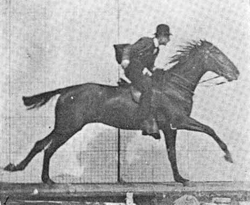 |
In April of
1873 the Daily Alta California reported that Muybridge
had photographed the horse ‘Occident’, owned by
Governor Leland Stanford.
The newspaper stated in the story that Muybridge's photographs
had in fact shown the animal "frozen" in mid stride.
Word will quickly spread around the U.S. and then the world,
of what Muybridge's work was actually proving - that horses
leave the ground, and that recorded motion was possible. |
|
| One
set of stop-action-series photographs (above) by Muybridge
shows the horse in a full gallop - "a perfect likeness".
Notice the shadow against the wall. |
|
The
frame (above) from the Muybridge disc shows all four
hooves off the ground at the same time - "frozen" |
|
|
| |
|
|
|
| |
Without identifying Muybridge
by name, the New York Times will report in May of 1873 that "A
San Francisco photographer is declared to have obtained a perfect likeness
of the horse Occident going at full speed." Muybridge
had taken a path that would lead directly towards an art form that would
cause landscape photography to pale in comparison. No one had ever seen
anything like this before.
|
|
| |
|
|
|
| |
|
|
|
| |
|
|
| |
|
|
|
| |
| 1874
PIERRE JULES CESAR JANSSEN (1824 - 1907)
A long barreled canon-like
automatic camera was invented in 1874 by an outstanding pioneer
of modern astronomical photography, Jules Janssen. Janssen used
the revolving plate technique and called his camera a
'pistol'. Janssen's method used the forerunner of a
number of 'gun' cameras with a slowly revolving
plate and shutter operated by clockwork. The photos were taken
every 70 seconds along the margin of the negative and he used
his pistol to record a 48 image sequence of the transit of Venus
across the sun at an exposure rate of 1.5 seconds (Braun,
Picturing Time; The Work of Etienne-Jules Marey, pp395 suggests
Marey mistook the time required for one revolution of the plate,
estimating it at 70 seconds. She further suggests writers through
the ages have carried this mistake onward in their reporting).
His gun camera worked with two separate slotted disks. One disk
was stationary and had one slot. The other had 12 slots and
required 18 seconds to revolve once. The plate moved 48 times,
intermittently, during a revolution covering approximately 70
seconds. The overlapping of the two disks allowed for the exposure.
The reader will recall
the work of Jeremiah Horrox (SEE 1639
JEREMIAH HORROX) in observing the same astronomical event
exactly two hundred and thirty five years earlier, except in
Horrox's case, without the ability to 'capture' the image of
what he saw. Janssen photographed Venus from Japan. |
|
|
|
| |
|
Pierre Jules Cesar
Janssen
|
|
| |
|
|
|
| |
|
|
| |
|
|
|
| |
|
|
| |
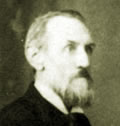 |
1875
JOHN ARTHUR ROEBUCK RUDGE (1837 - 1903)
The Rudge Projector,
or Phantascope, (not to be confused with
the Phantoscopes of Jenkins or Robertson)
has been described as a combination of the works of Beale (the
Choreutoscope, SEE BEALE
1872, and SEE MOLTENI 1865),
Brown ( the Uchatius‚€™ Lantern Wheel of Light SEE
BROWN 1869), and Wheatstone (Stereoscopes,
SEE WHEATSTONE 1838).
Rudge‚€™s version was considered the most fluid of pictures to
date due in part to the intermittent movement between frames.
John A. R. Rudge |
The
Phantascope (below-right) consisted
of seven photographic slides, which were all posed. The subject
appeared to remove his own head from off his shoulders through
the tricky work of the photographer or darkroom shenanigans.
Rudge used a circular lamp surrounded by a revolving drum which
when turned quickly by a handle-crank, the slides would equally
turn quite fast giving the appearance of the ghostly deed. |
|
Five
years from now Rudge will be introduced to William Friese-Greene
who will be intrigued by what he saw from Rudge's work, and
will be ultimately influenced. Still later, Rudge manufactured
another lantern; this one containing four lenses each projecting
a photo-slide in sequence. Motion was imitated by a mirrored-shutter
redirecting the light source onto each slide as it passed.
In one of the slide series, Friese-Greene played the part of
subject. The Phantascope was also called the
Biophantic.
|
|
|
| |
|
The Phantascope
(above) of John Arthur Roebuck Rudge
|
|
| |
|
|
|
| |
|
|
|
| |
|
|
| |
|
|
|
| |
|
|
|
| |
1875
JOHANNES GANZ ( - )
|
|
|
| |
Ganz was a Swiss photographer,
dealer and lantern manufacturer from Zurich. This year he builds his Pinakoscop,
a sciopticon lantern. Ganz was a former lithographer
who worked in sleight-of-hand. The company is still in business (2007). |
|
| |
|
|
|
| |
|
|
|
| |
1876
WORDSWORTH (WOODSWORTH?) DONISTHORPE (1848 - 1914) |
|
| |
He described a strip of
paper with photographs on it equal distances from each other. Each would
be wound from one cylinder to another and then seen through either the
Phenakistoscope or Zoetrope. |
|
| |
|
|
|
| |
|
|
|
| |
|
|
| |
|
|
| |
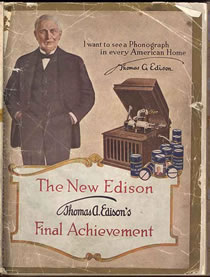 |
1877
THOMAS ALVA EDISON (1847 - 1931)
Edison
announced the invention of his Phonograph by which
sound could be recorded mechanically on a tinfoil cylinder. The
Phonograph will become a monumental invention in
it's own right, but also a major step towards sound recording in
motion picture history.
Shortly after Edison's announcement, the Scientific American
reported on the Phonograph as follows;
"It
is already possible by ingenious optical contrivances to throw stereoscopic
photographs of people on screens in full view of an audience. Add
the talking phonograph to counterfeit their voices, and it would
be difficult to carry the illusion of real presence much further."
- Scientific
American, December 1877
Edison
and his Phonograph From An 1877 Catalog Advertisement (left)
[Source: U.S. Library of Congress, The
History of the Edison Cylinder Phonograph] |
|
|
| |
|
|
|
| |
|
|
| |
|
|
|
| |
1877
CHARLES-EMILE REYNAUD (1844 - 1918)
Reynaud
improved on the Zoetrope and patented his machine
in 1877 in Paris. He called it a Praxinoscope.
It was similar in principle to the Zoetrope except
it had rectangular mirrors instead of slots. The mirrors were set
around and inner drum to reflect the circling images. These were
drawn and painted beautifully by Reynaud. The movement seen was
much smoother than the Zoetrope. Reynaud went on
to produce his Praxinoscope Theatre.
In the theatre, the flying images reflected in the mirrors of the
central drum are viewed through a proscenium, which contained stationary
scenery so as to give a sense of looking at the production on a
stage-like setting. Reynaud was diligent in his work, producing
the Projecting Praxinoscope. This projector presented
a cast of circus performers or the like onto the screen. |
|
| Reynaud
patented his Praxinoscope in 1877 and produced this version in 1878
(above-right). The Praxinoscope was an optical
toy for the purpose of imitating movement. It utilized drawings
and paintings done by Reynaud initially. The pictures faced inward
on the outer drum with mirrors placed facing outward on the inner
drum. One looked into the mirrors as the outer drum rotated, and
saw what appeared to be natural sequential movement. |
|
The
Praxinoscope of Charles-Emile Reynaud was placed
within the Praxinoscope Theatre (right).
The Theatre was a box, which opened like a suitcase. The viewer
of the Praxinoscope Theatre then looked through
a rectangular hole in the top to see a background printed with what
looked like a stage. Through the image of this stage on the background,
was another hole where it would appear if the curtains had been
drawn back. Within this opening you would see the Praxinoscope's
images as if moving. Subject matter would be circus acts, horse
races etc.
|
|
|
|
| |
|
|
| |
|
|
| |
|
|
|
| |
|
|
|
| |
1878
WORDSWORTH (WOODSWORTH?) DONISTHORPE (1848 - 1914) |
|
| |
Donisthorpe finishes initial
work on his Kinesigraph which may have been designed
with Edison's Phonograph in mind. Edison had shown interest
in Donisthorpe's machine for the purpose of uniting sound with movement,
and would later meet with both Muybridge (1883 and 1888) and Marey (1889)
for the same reason. In 1887 Friese-Greene would contact Edison regarding
synchronized sound development. Edison's announcement of his Phonograph
in New Jersey and write-up in the American press regarding the sound-pictures
possibilities caused Donisthorpe to approach the English magazine Nature
for the following quote in it's first copy of 1878; |
|
| |
|
|
|
| |
"Ingenious
as this suggested combination [December 1877 Scientific American
article on Edison's Phonograph] is, I believe I
am in the position to cap it. By combining the phonograph with the Kinesigraph
I will undertake not only to produce a talking picture of Mr. Gladstone
which, with motionless lips and unchanged expression shall positively
recite his latest anti-Turkish speech in his own voice and tone. Not only
this, but the life-size photograph itself shall move and gesticulate precisely
as he did when making the speech, the words and gestures corresponding
as in real life. Surely this is an advance upon the conception of the
Scientific American! I think it will be admitted that by this means a
drama acted by daylight or magnesium light may be recorded and reacted
on the screen or sheet of a magic lantern, and with the assistance of
the phonograph the dialogues may be repeated in the very voices of the
actors. When this is actually accomplished the photography of colors will
alone be wanting to render the representation absolutely complete,and
for this we shall not, I trust, have long to wait." |
|
| |
|
|
|
| |
|
|
|
| |
|
|
|
| |
1878
LOUIS ARTHUR DUCOS DU HAURON (1837 - 1920)
Du
Hauron publishes Les Couleurs en Photographie
in 1869 describing his theory of subtractive colour photography.
This year he moves forward publishing Photographie en Couleur
describing this process in more precise terms. |
|
| |
|
|
|
| |
|
|
|
| |
|
|
| |
|
|
| |
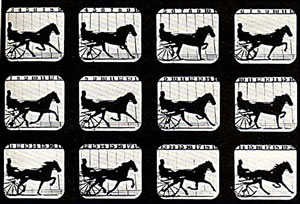 |
1877-1878
EADWEARD JAMES MUYBRIDGE (1830 - 1904)
Stanford
and Muybridge had discussed the idea of a horse's legs being off
the ground or not, when trotting. To prove conclusively the truth,
Muybridge rigged his cameras to photograph in stop-action, a series
of pictures which showed that in fact, the four hooves did leave
the ground at one point, at the same time. The cameras had been
set along the track on the outer rim, with triggered shutters set
at appropriate intervals. The horse was 40 feet from the camera
and the exposure was 1/1000 of a second. The exposure was triggered
electro-magnetically using wires across the track. This event has
gone down in history as one of the most important moments in the
story of moving picture development. The series was published later
in 1881 under the title 'Attitudes of Animals in Motion'.
A patent was granted for this method of stop-action series
photography in 1897. |
| A
proof of twelve photos (above) of Stanford's superb trotter,
'Occident' taken at the Palo Alta track and is from the 1881 published
series. At the time these photos were taken, Occident was traveling
22 1/2 mph. This lanternslide and others like it reside at the Kingston-on-Thames
Library and Museum. |
|
|
| |
|
|
|
| |
|
|
|
| |
1879
EADWEARD JAMES MUYBRIDGE (1830 - 1904)
The
Zoopraxiscope, a moving picture projector, is designed
and introduced by Muybridge. He will take it on tour with him in
the upcoming years to use in his lectures, namely, Paris in 1881
and 1882. Upon his return to America the University of Pennsylvania
granted him funds in the amount of $5,000 to advance his research
in stop-action series photography [final costs
would almost reach $40,000]. Between the years 1883-1885, Muybridge
took more than 100,000 photographs, which would later be published
in 1887. The Zoopraxiscope operated by projecting
images drawn from photographs (by Faber and Eakins), rapidly
and in succession onto the screen. The photographs were painted
onto a glass disc [even though Langenheim's Hyalotype process
allowed photographs to be copied onto glass] which rotated,
thereby producing the illusion of motion. From this point forward
in time, Muybridge's work began to clearly show that the possibility
of actual moving pictures or cine-photography, was a reality and
not far from perfection. |
|
The
image to the right of a horse jumping provides us with a marvelous
rendering of how the moving horse would have appeared through the
Zoopraxiscope, to the viewer in 1879. We also,
highly recommend The
University Archives and Records Center - Guide to the Eadweard Muybridge
Collection at The University Of Pennsylvania.
This
"wonderful California horse story" was reported in the
Palo 'Alta' ; |
| Mr.
Muybridge has laid the foundation of a new method of entertaining
the people, and we predict that his instantaneous photographic,
magic-lantern zoetrope will make the round of the civilized world." |
|
|
| |
|
|
|
| |
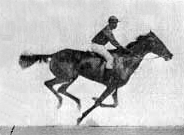 |
The
Muybridge Zoopraxiscope (above) used images
drawn from Muybridge's stop-action-series photographs.
They were initially drawn by Erwin Faber, and later by Thomas
Eakins.
The disk was rotated between light and lens and thereby provided
a sense of motion. |
|
Like
Edison, Muybridge had produced his own photographs for the purpose
of creating motion on a screen. This animation of Sallie Gardner
(left) is from a proof sheet, taken of the horse on June 19,
1878.
It was later copied over by Erwin Faber onto a Zoopraxiscope
Plate Disk.
Cine-photography had become a reality. |
| A
must see website on Muybridge is of course the U
of Penn. |
Proof
sheet (above) taken by Muybridge which was transposed
over to the disk. |
|
|
| |
|
|
|
| |
|
|
|
| |
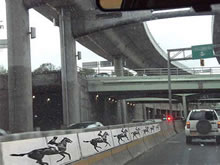 |
See
a 'Street Zoopraxiscope' in action in an urban landscape.
Once again, the pictures
never move. There are no glass plates and no machine. Just photos
of the Muybridge horse and you in your car.
Go to You Tube and see the
illusion here. |
|
|
|
| |
|
|
| |
|
|
|
| |
|
|
|
|
|
|
| |
1879
ELECTRIC CAMERA OBSCURA?
The December 9th 1878
edition of the magazine Punch
spoofed Thomas Edison's version of sending conversations over
long distances. It was the same idea Bell had been working on
for years and had patented in February 1876, called the Telephone.
The device identified in Punch was called 'Edison's
Telephonoscope' and featured a drawing by George du
Maurier of father and mother figures sitting in their home before
what appears to be (below) a cinema screen,
television or video display. They are talking into and listening
from, cylinders in their hands.
Interestingly, Edison's
Telephonoscope idea was an audio-only device with limited
research attached to it, and had only been thought of for patenting
a few months earlier. There was no mention of a visual component
in Edison's patent, on what eventually became the Megaphone.
This publication of
a drawing/decription of an audio-only device, into a full-blown
audio-visual transmitter capable of video-conferencing is typical
of the fever, which was sweeping the world in the late 19th
century regarding the imminence of motion pictures. |
| |
|
Punch's
Almanac For 1879 (right)
shows du Maurier's depiction of an 'electric
camera obscura' capable of providing real-time audio-video
across continents. Punch and it's writer obviously felt adding
a picture to a potential 'ear telescope'
would help circulation. The New York Herald in June 1878 had
their say on Edison's Telephonoscope, with the heading;
'The Megaphone'
"The telephonoscope was a device
for receiving sound over great distance. Its basic design consisted
of long paper funnels to the ends of which were connected flexible
tubes for insertion into the listener's ears. When used with
a speaking tube, the device reportedly enabled conversation
to be "carried on through a distance of one and a half
to two miles in an ordinary tone of voice. A low whisper, uttered
without using the speaking trumpet, is distinctly audible at
a distance of a thousand feet, and walking through grass and
weeds may be heard at a much greater distance".
The Herald's sister-paper
The Sun ran the same story but with the heading 'Edison's
Ear Telescope'. |
|
| |
Punch's
Almanac For 1879 Offering Big Screen Home Theatre In The Victorian
Age (above) |
| |
|
| The
descriptive story accompanying the picture reads:
EDISON'S TELEPHONOSCOPE
(TRANSMITS LIGHT AS WELL AS SOUND).
'Every evening, before going to bed,
Pater and Materfamilias set up an electric camera-obscura over
their bedroom mantel-piece and gladden their eyes with the sight
of the Antipodes, and converse gaily with them through the wire'.
Paterfamilias
(in Wilton Place) "BEATRICE, COME CLOSER - I WANT
TO WHISPER."
Beatrice (from Ceylon) "YES ,PAPA
DEAR"
Paterfamilias "WHO IS THAT CHARMING YOUNG
LADY PLAYING ON CHARLIE'S SIDE?"
Beatrice "SHE'S JUST COME OVER FROM ENGLAND,
PAPA. I'LL INTRODUCE YOU TO HER AS SOON AS THE GAME'S OVER." |
| |
|
| The
dimensions of the screen in the drawing (above) by du
Maurier have been determined to be almost identical to an aspect
ratio of 2.76:1. Another way to put it is to say the wide screen
image depicted in this 1879 India ink drawing is equal to today's
Ultra Panavison 70mm film format. Although large format film has
been used since the late 1880's, this ratio was not seen until
the 1950's. For more on The Telephonoscope SEE
ROBIDA 1883 |
| |
|
|
|
| |
|
|
|
| |
|
|
| |
|
|
|
| |
|
|
|
| |
1879
MAXIMILLIAN SKLADANOWSKY (1863 - 1939) |
|
|
| |
At sixteen years of age,
along with brother Emile, Max Skladanowsky helps father Carl to present
his 'Nebula Pictures', which were magic lantern Dissolving
Views of natural disasters. Themes included fires, storms and
earthquakes. They were presented at popular venues like the Town Hall
in Berlin. Skladanowsky will build his Bioscop projector
basing it on the Dissolving View technique. |
|
| |
|
|
|
| |
|
|
|
| |
|
|
|
| |
|
|
|
| |
|
|
|
| |
|
|
|
| |
|
|
|
| |
|
|
|

|
| |



